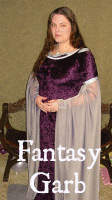


|
Item -
a gamurra/ kirtle of lavender linen garded with amarnate* cotten,
lined with canvas, in the middle class Florentine style.
(1580's)
This piece of garb was originally intended
for 'more period whenching garb' for the annual Wayward Tavern Feast.
Also intended for tourney and camping garb, it was meant to be
practicle and cool, for summer wear. While wool was a more popular
for outer garments in the 1500's, I had read about linen being used
for infants outerwear (Dress in the
Middle Ages, p22) and 15th century
inventories (Florence countryside) state fabrics of vegetable fibres
were used to maker outer garments (Dress in the Middle Ages p 44). Faustian (cotton and linen) being made in
Northern Italy ('Faustian-a-Napes' was used in Elizabethan England -
QEWU). Faustian was used for "doublets and for making
summer outergarments" (Dress in the
Middles Ages, p 23). Queen Elizabeth's Wardrobe Unlock'd also mentions Faustian being used to make doublets.
So, as wool and I do not agree, I decided to make cool linen garb for
the Innilgard hot summers (often over 35- 45 deg. Celcius).
 
|

|
Main inspiration came from Vincenzo
Campi's paintings of Middle class Italy, in the late 1500's.
The Fruit Seller
(upper left) shows front
gards similar in pattern to those I used. The Kitchen Scene (upper right) shows the back garding. This
painting also shows back lacing which I normally employ in
my garb. However, as I was intending on using this for
camping garb also, it had to be easily put on by myself.
Front lacing was easier for this. Examples of front lacing can be seen (left)
in a painting, attributed to Campi, called Christ in the House of Mary and Martha.
The woman in the background
right, of the Fruit Seller
could also possibly have a
front laced gamurra. Pietro Ronzelli's Nativita di Maria (below left) also shows front lacing as well
as the contrasting garding (Florentine). All portraits show
examples of partlets being worn with the middleclass
'outfit'. This is 'ladder laced'.
|
|

|
Below are closer examples of the
garding. Cartridge pleating can also be seen, in
The Fruit Seller
(below right) to attatch
the skirt to the upper body.I thought also interesting to
note the woman who has tied her sleeves behind her back to
keep them out to the way while working.
 
|
My
Interpretation:
|

|
This piece of tourney garb is
practicle and cool, in linen.The upper bodies were made with
front lacing for ease of use. It was lined with canvas and
linen. The gards were made from bias-cut strips of cotton
drill (this was a budget outfit. Luckily I had managed to
get the linen on sale) which were hand sewn onto the gown.
The skirt was cartridge pleated to the upper bodies. In an
effort to keep the bodies flat, without wearing a corset, I
tried a method used on the Festive Atyre website. This was a new method to me and
seems to work reasonably well.
Left is the finished outfit. There was
enough material to make a matching, summer outfit for Morgan
(aged 2 1/2 years, here). Below are details of the garding.
The apron was copied from The Kitchen Scene, being a dark bluish colour. Linen was
quoted as being used for these protective coverings
(Dress in the Middle Ages,
p 22)
 
|
|

|
The finished outfit and linen
'apron' worn at the Wayward Tvern Feast, December,
2003.

|
BIBLIOGRAPHY:
I must give credit to the wonderful work at the Festive Atyre -
http://homepage.mac.com/festive_attyre/research/wkclass which was a source of information and inspiration to
me.
Piponnier, Francoise & Mane, Perrine
Dress in the Middle Ages,
Yale University Press, New Haven,
1997. ISBN: 0-300-08691-1
Arnold, Janet. Queen Elizabeth's Wardrobe Unlock'd.
|



|


















